spare wheel TOYOTA AYGO 2015 Owners Manual (in English)
[x] Cancel search | Manufacturer: TOYOTA, Model Year: 2015, Model line: AYGO, Model: TOYOTA AYGO 2015Pages: 440, PDF Size: 22.97 MB
Page 312 of 440
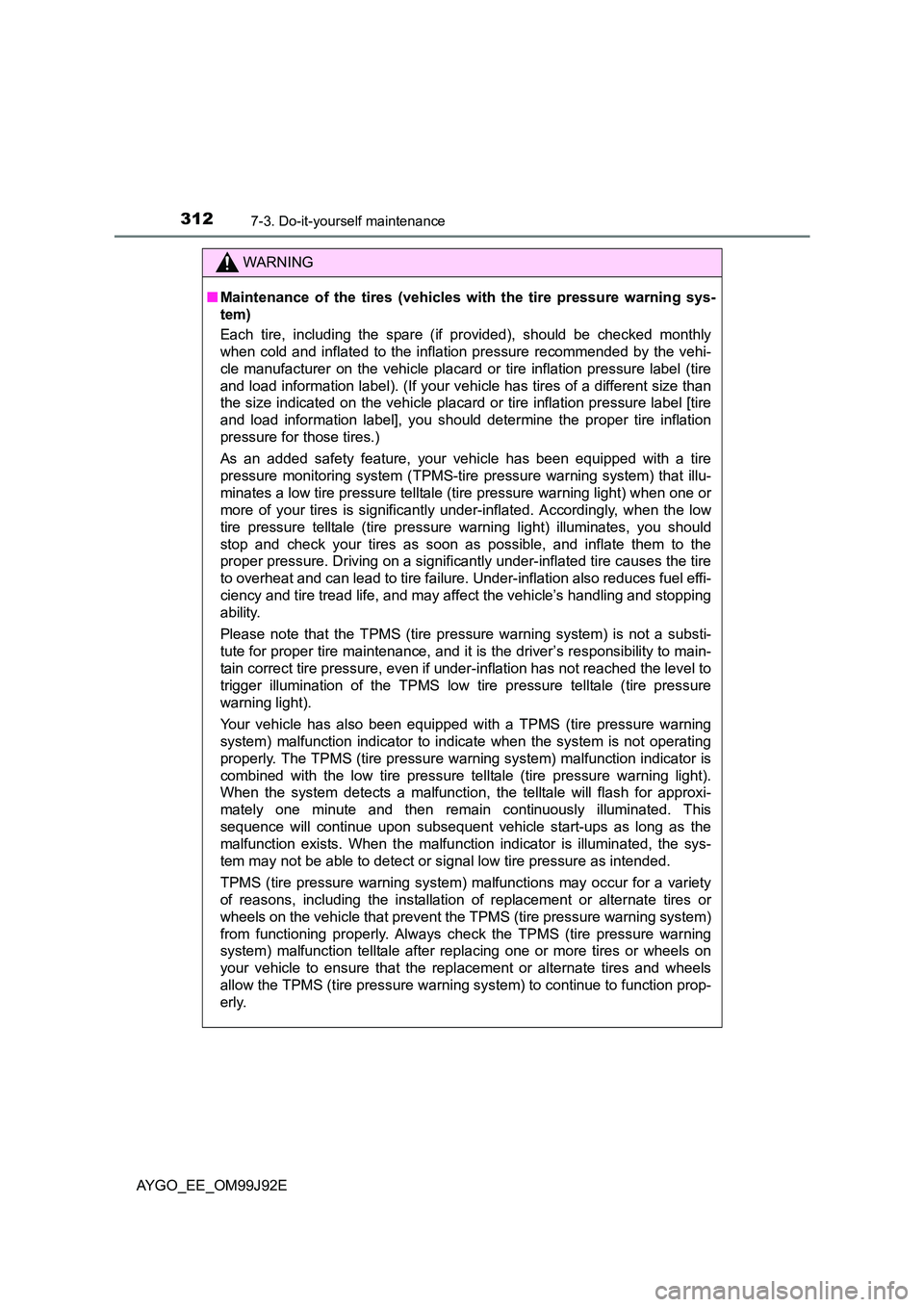
3127-3. Do-it-yourself maintenance
AYGO_EE_OM99J92E
WARNING
■ Maintenance of the tires (vehicles with the tire pressure warning sys-
tem)
Each tire, including the spare (if provided), should be checked monthly
when cold and inflated to the inflation pressure recommended by the vehi-
cle manufacturer on the vehicle placard or tire inflation pressure label (tire
and load information label). (If your vehicle has tires of a different size than
the size indicated on the vehicle placard or tire inflation pressure label [tire
and load information label], you should determine the proper tire inflation
pressure for those tires.)
As an added safety feature, your vehicle has been equipped with a tire
pressure monitoring system (TPMS-tire pressure warning system) that illu-
minates a low tire pressure telltale (tire pressure warning light) when one or
more of your tires is significantly under-inflated. Accordingly, when the low
tire pressure telltale (tire pressure warning light) illuminates, you should
stop and check your tires as soon as possible, and inflate them to the
proper pressure. Driving on a significantly under-inflated tire causes the tire
to overheat and can lead to tire failure. Under-inflation also reduces fuel effi-
ciency and tire tread life, and may affect the vehicle’s handling and stopping
ability.
Please note that the TPMS (tire pressure warning system) is not a substi-
tute for proper tire maintenance, and it is the driver’s responsibility to main-
tain correct tire pressure, even if under-inflation has not reached the level to
trigger illumination of the TPMS low tire pressure telltale (tire pressure
warning light).
Your vehicle has also been equipped with a TPMS (tire pressure warning
system) malfunction indicator to indicate when the system is not operating
properly. The TPMS (tire pressure warning system) malfunction indicator is
combined with the low tire pressure telltale (tire pressure warning light).
When the system detects a malfunction, the telltale will flash for approxi-
mately one minute and then remain continuously illuminated. This
sequence will continue upon subsequent vehicle start-ups as long as the
malfunction exists. When the malfunction indicator is illuminated, the sys-
tem may not be able to detect or signal low tire pressure as intended.
TPMS (tire pressure warning system) malfunctions may occur for a variety
of reasons, including the installation of replacement or alternate tires or
wheels on the vehicle that prevent the TPMS (tire pressure warning system)
from functioning properly. Always check the TPMS (tire pressure warning
system) malfunction telltale after replacing one or more tires or wheels on
your vehicle to ensure that the repl acement or alternate tires and wheels
allow the TPMS (tire pressure warning system) to continue to function prop-
erly.
Page 358 of 440
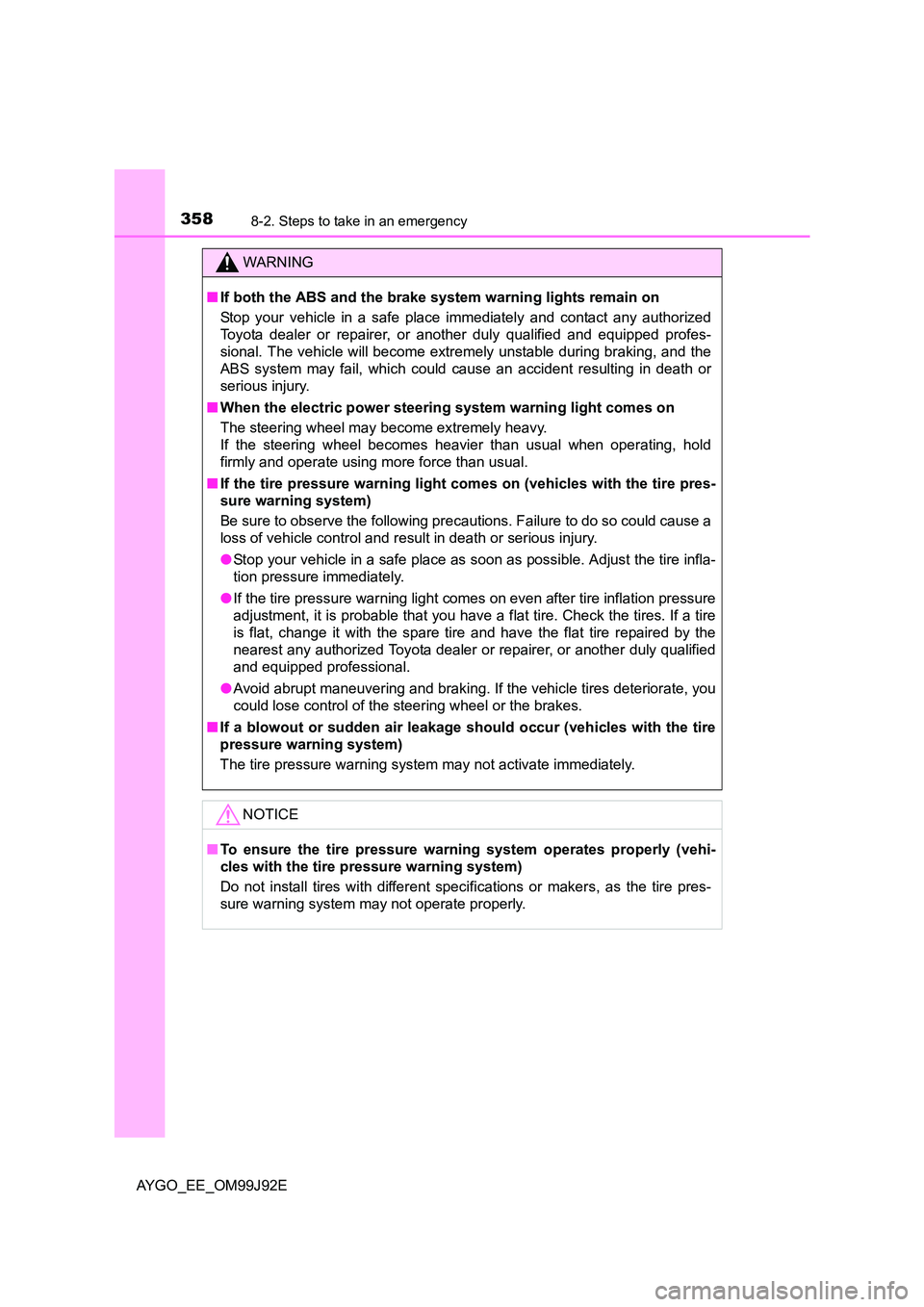
3588-2. Steps to take in an emergency
AYGO_EE_OM99J92E
WARNING
■ If both the ABS and the brake system warning lights remain on
Stop your vehicle in a safe place immediately and contact any authorized
Toyota dealer or repairer, or another duly qualified and equipped profes-
sional. The vehicle will become extremely unstable during braking, and the
ABS system may fail, which could cause an accident resulting in death or
serious injury.
■ When the electric power steering system warning light comes on
The steering wheel may become extremely heavy.
If the steering wheel becomes heavier than usual when operating, hold
firmly and operate using more force than usual.
■ If the tire pressure warning light comes on (vehicles with the tire pres-
sure warning system)
Be sure to observe the following precautions. Failure to do so could cause a
loss of vehicle control and result in death or serious injury.
● Stop your vehicle in a safe place as soon as possible. Adjust the tire infla-
tion pressure immediately.
● If the tire pressure warning light comes on even after tire inflation pressure
adjustment, it is probable that you have a flat tire. Check the tires. If a tire
is flat, change it with the spare tire and have the flat tire repaired by the
nearest any authorized Toyota dealer or repairer, or another duly qualified
and equipped professional.
● Avoid abrupt maneuvering and braking. If the vehicle tires deteriorate, you
could lose control of the steering wheel or the brakes.
■ If a blowout or sudden air leakage should occur (vehicles with the tire
pressure warning system)
The tire pressure warning system may not activate immediately.
NOTICE
■ To ensure the tire pressure warning system operates properly (vehi-
cles with the tire pressure warning system)
Do not install tires with different specifications or makers, as the tire pres-
sure warning system may not operate properly.
Page 361 of 440
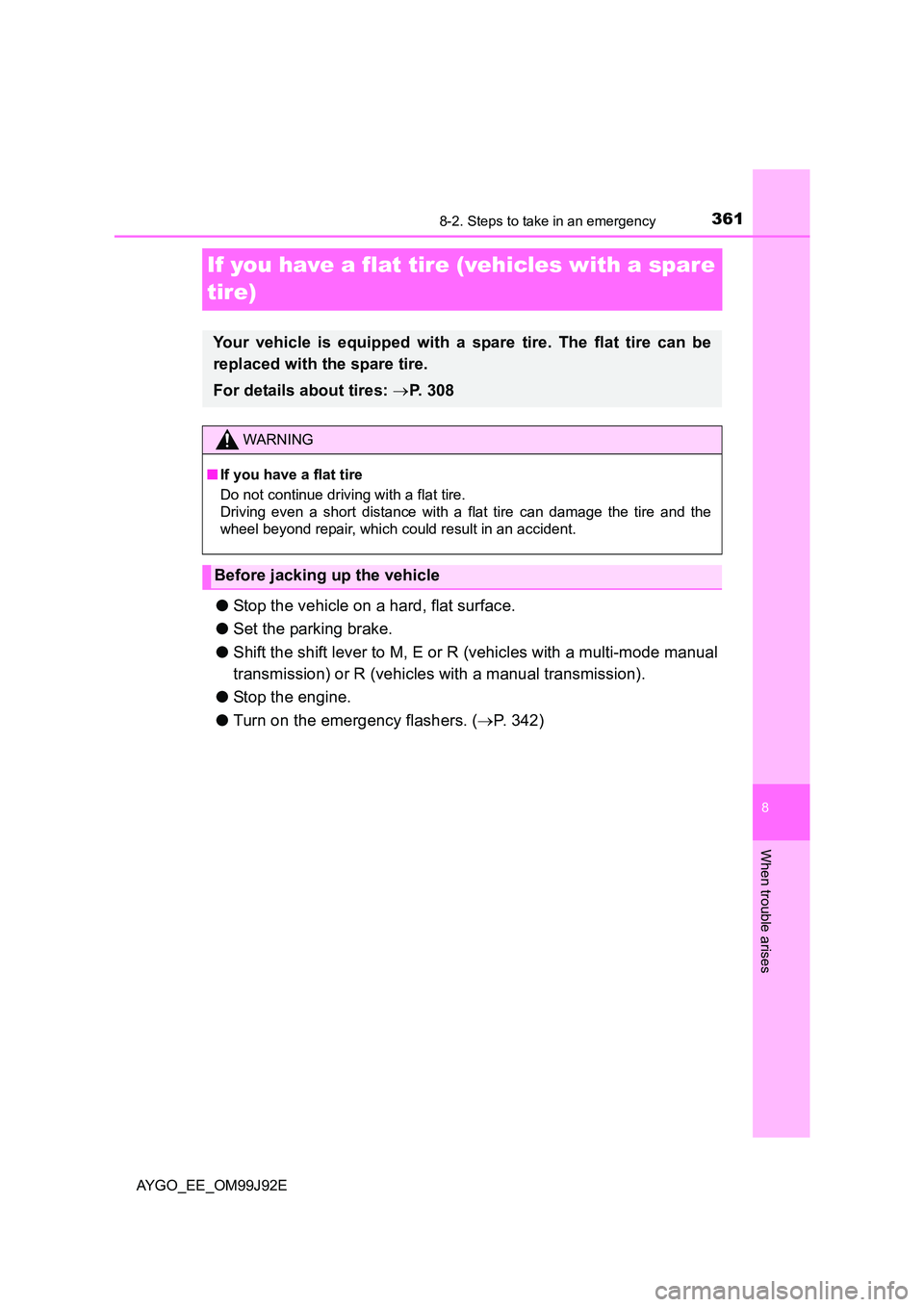
3618-2. Steps to take in an emergency
8
When trouble arises
AYGO_EE_OM99J92E
If you have a flat tire (vehicles with a spare
tire)
● Stop the vehicle on a hard, flat surface.
● Set the parking brake.
● Shift the shift lever to M, E or R (vehicles with a multi-mode manual
transmission) or R (vehicles with a manual transmission).
● Stop the engine.
● Turn on the emergency flashers. (→P. 342)
Your vehicle is equipped with a spare tire. The flat tire can be
replaced with the spare tire.
For details about tires: →P. 3 0 8
WARNING
■ If you have a flat tire
Do not continue driving with a flat tire.
Driving even a short distance with a flat tire can damage the tire and the
wheel beyond repair, which could result in an accident.
Before jacking up the vehicle
Page 362 of 440
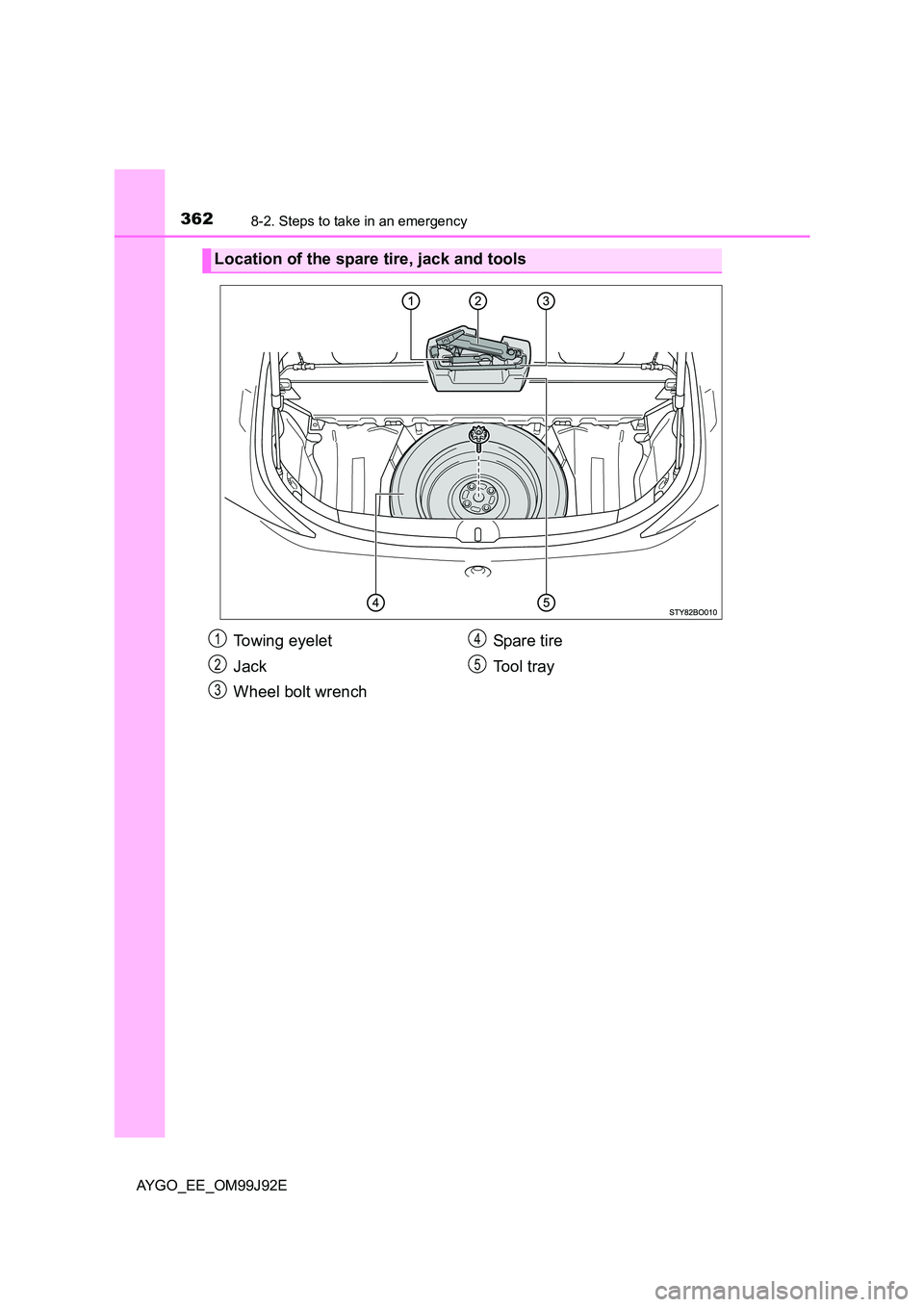
3628-2. Steps to take in an emergency
AYGO_EE_OM99J92E
Location of the spare tire, jack and tools
Towing eyelet
Jack
Wheel bolt wrench
Spare tire
Tool tray
1
2
3
4
5
Page 369 of 440

3698-2. Steps to take in an emergency
8
When trouble arises
AYGO_EE_OM99J92E
Remove any dirt or foreign mat-
ter from the wheel contact sur-
face.
If foreign matter is on the wheel
contact surface, the wheel bolts
may loosen while the vehicle is in
motion, causing the tire to come
off.
Install the spare tire and loosely tighten each wheel bolt by hand by
approximately the same amount.
When replacing a steel wheel
with a steel wheel, tighten the
wheel bolts until the tapered
portion comes into loose con-
tact with the disc wheel seat.
When replacing an aluminum
wheel with a steel wheel,
tighten the wheel bolts until the
tapered portion comes into
loose contact with the disc
wheel seat.
Lower the vehicle.
Installing the spare tire
1
2
Tapered portion
Disc wheel seat
Tapered portion
Disc wheel seat
3
Page 370 of 440
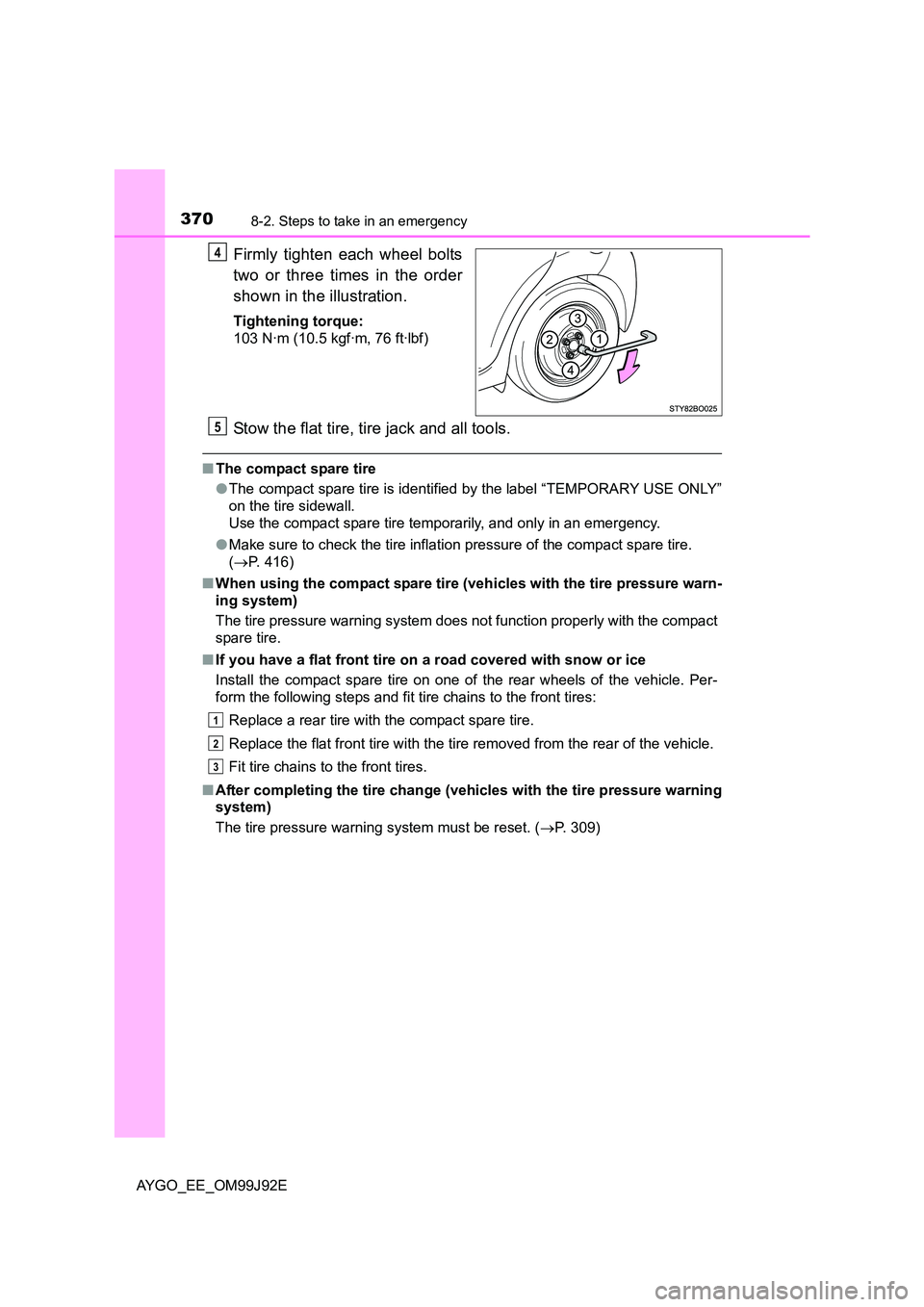
3708-2. Steps to take in an emergency
AYGO_EE_OM99J92E
Firmly tighten each wheel bolts
two or three times in the order
shown in the illustration.
Tightening torque:
103 N·m (10.5 kgf·m, 76 ft·lbf)
Stow the flat tire, tire jack and all tools.
■ The compact spare tire
● The compact spare tire is identified by the label “TEMPORARY USE ONLY”
on the tire sidewall.
Use the compact spare tire temporarily, and only in an emergency.
● Make sure to check the tire inflation pressure of the compact spare tire.
( →P. 416)
■ When using the compact spare tire (vehicles with the tire pressure warn-
ing system)
The tire pressure warning system does not function properly with the compact
spare tire.
■ If you have a flat front tire on a road covered with snow or ice
Install the compact spare tire on one of the rear wheels of the vehicle. Per-
form the following steps and fit tire chains to the front tires:
Replace a rear tire with the compact spare tire.
Replace the flat front tire with the tire removed from the rear of the vehicle.
Fit tire chains to the front tires.
■ After completing the tire change (vehicles with the tire pressure warning
system)
The tire pressure warning system must be reset. ( →P. 309)
4
5
1
2
3
Page 372 of 440
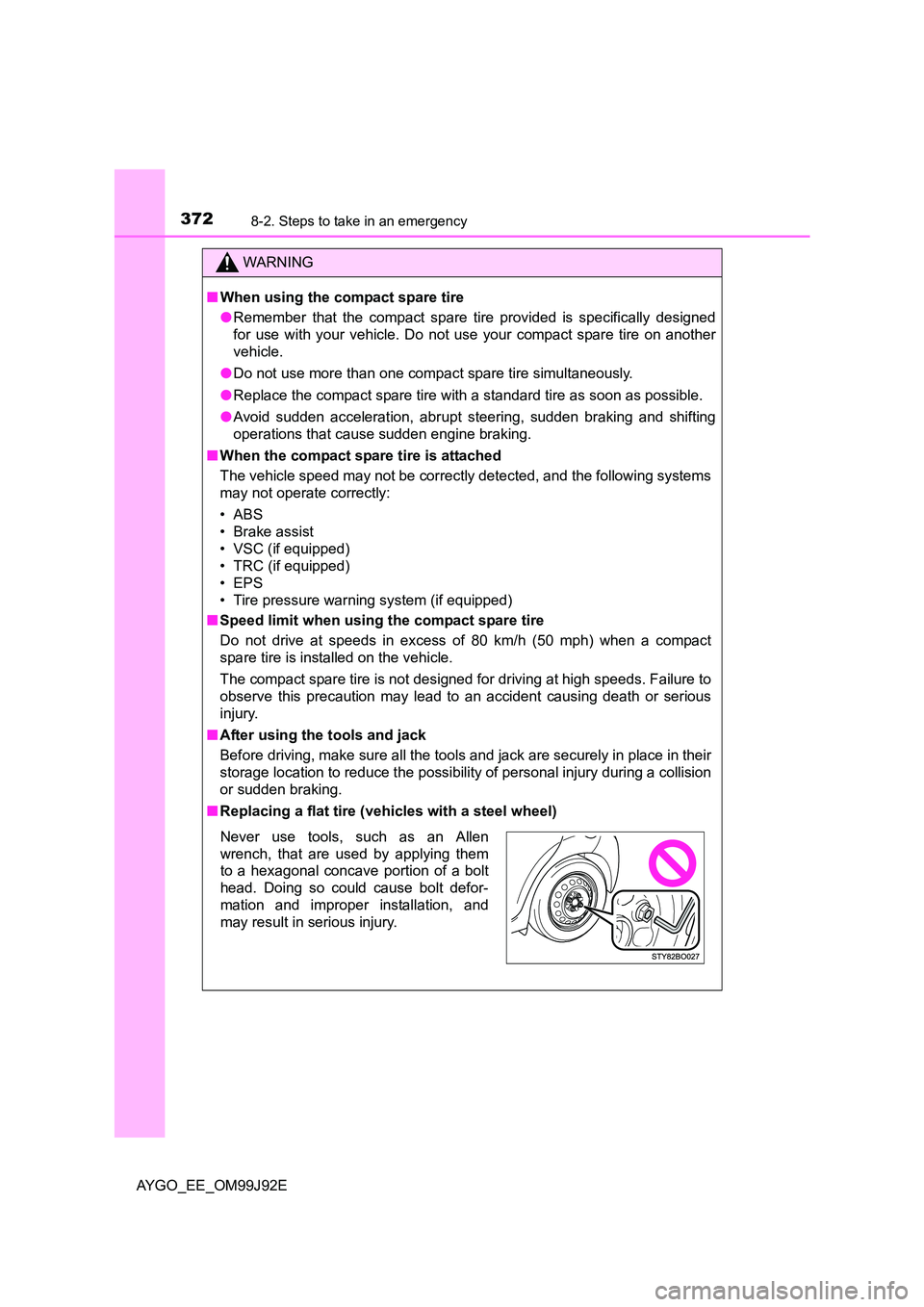
3728-2. Steps to take in an emergency
AYGO_EE_OM99J92E
WARNING
■ When using the compact spare tire
● Remember that the compact spare tire provided is specifically designed
for use with your vehicle. Do not use your compact spare tire on another
vehicle.
● Do not use more than one compact spare tire simultaneously.
● Replace the compact spare tire with a standard tire as soon as possible.
● Avoid sudden acceleration, abrupt steering, sudden braking and shifting
operations that cause sudden engine braking.
■ When the compact spare tire is attached
The vehicle speed may not be correctly detected, and the following systems
may not operate correctly:
• ABS
• Brake assist
• VSC (if equipped)
• TRC (if equipped)
• EPS
• Tire pressure warning system (if equipped)
■ Speed limit when using the compact spare tire
Do not drive at speeds in excess of 80 km/h (50 mph) when a compact
spare tire is installed on the vehicle.
The compact spare tire is not designed for driving at high speeds. Failure to
observe this precaution may lead to an accident causing death or serious
injury.
■ After using the tools and jack
Before driving, make sure all the tools and jack are securely in place in their
storage location to reduce the possibility of personal injury during a collision
or sudden braking.
■ Replacing a flat tire (vehicles with a steel wheel)
Never use tools, such as an Allen
wrench, that are used by applying them
to a hexagonal concave portion of a bolt
head. Doing so could cause bolt defor-
mation and improper installation, and
may result in serious injury.
Page 374 of 440

3748-2. Steps to take in an emergency
AYGO_EE_OM99J92E
If you have a flat tire (vehicles without a
spare tire)
● Stop the vehicle in a safe place on a hard, flat surface.
● Set the parking brake.
● Shift the shift lever to N.
● Stop the engine.
● Turn on the emergency flashers. (→P. 342)
Your vehicle is not equipped with a spare tire, but instead is
equipped with an emergency tire puncture repair kit.
A puncture caused by a nail or screw passing through the tire
tread can be repaired temporarily with the emergency tire punc-
ture repair kit.
WARNING
■ If you have a flat tire
Do not continue driving with a flat tire.
Driving even a short distance with a flat tire can damage the tire and the
wheel beyond repair, which could result in an accident.
Driving with a flat tire may cause a circumferential groove on the side wall.
In such a case, the tire may explode when using a repair kit.
Before repairing the vehicle
Page 417 of 440
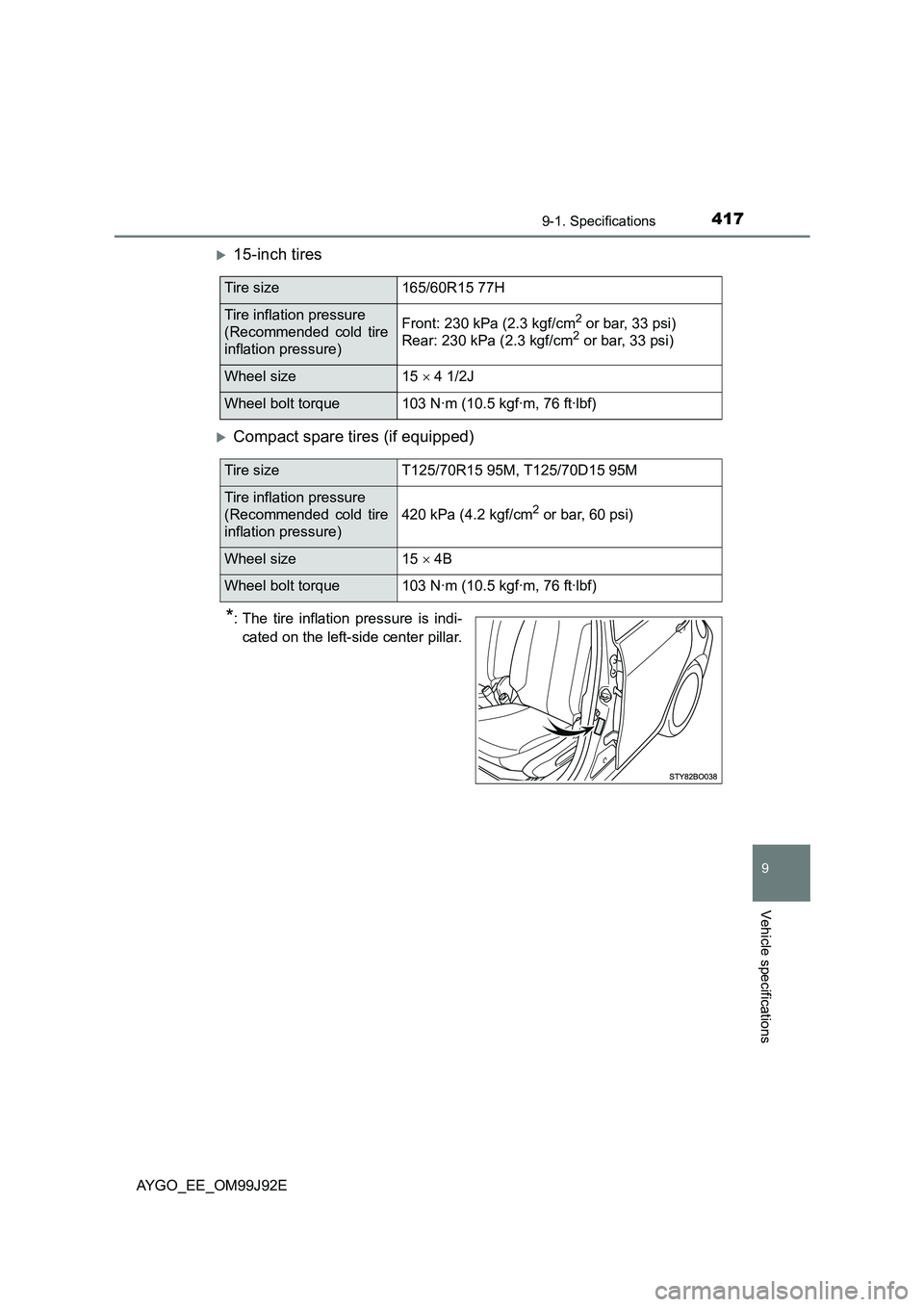
4179-1. Specifications
9
Vehicle specifications
AYGO_EE_OM99J92E
�X15-inch tires
�XCompact spare tires (if equipped)
*: The tire inflation pressure is indi-
cated on the left-side center pillar.
Tire size165/60R15 77H
Tire inflation pressure
(Recommended cold tire
inflation pressure)
Front: 230 kPa (2.3 kgf/cm2 or bar, 33 psi)
Rear: 230 kPa (2.3 kgf/cm2 or bar, 33 psi)
Wheel size15 × 4 1/2J
Wheel bolt torque103 N·m (10.5 kgf·m, 76 ft·lbf)
Tire sizeT125/70R15 95M, T125/70D15 95M
Tire inflation pressure
(Recommended cold tire
inflation pressure)
420 kPa (4.2 kgf/cm2 or bar, 60 psi)
Wheel size15 × 4B
Wheel bolt torque103 N·m (10.5 kgf·m, 76 ft·lbf)
Page 435 of 440

435Alphabetical index
AYGO_EE_OM99J92E
Seat belts .................................... 30
Child restraint system
installation............................. 58
Cleaning and maintaining
the seat belt ........................ 286
Emergency Locking
Retractor............................... 31
How to wear your seat belt ..... 30
How your child should wear
the seat belt .......................... 31
Pregnant women, proper
seat belt use ......................... 32
Reminder light and buzzer .... 355
Seat belt pretensioners ........... 31
SRS warning light ................. 354
Seat heaters ............................. 268
Seats ................................. 123, 125
Adjustment ............................ 123
Adjustment
precautions ................. 124, 126
Child seats/child restraint
system installation ................ 58
Cleaning ................................ 285
Folding down the rear
seatbacks ........................... 125
Head restraint ....................... 127
Properly sitting in the seat....... 28
Seat heaters.......................... 268
Sensor
Automatic headlight
system ................................ 169
Service reminder indicators ..... 78
Shift lever
If the shift lever cannot be
shifted ................................. 390
Manual transmission ............. 163
Multi-mode manual
transmission ....................... 159
Shift lock system ..................... 390
Shopping bag hooks ............... 275
Side airbags ............................... 34
Side mirrors ............................. 131
Adjusting and folding ............ 131
Side turn signal lights ............. 165
Replacing light bulbs............. 339
Turn signal lever ................... 165
Smart entry & start system ..... 113
Antenna location ................... 113
Entry functions .............. 103, 107
Starting the engine................ 154
Warning light ................. 355, 359
Snow tires ................................ 198
Spare tire .................................. 361
Inflation pressure .................. 416
Storage location .................... 362
Specifications .......................... 406
Speed limiter ............................ 181
Speedometer .............................. 83
Steering lock .................... 152, 157
Steering lock system
warning light ....................... 359
Steering wheel ......................... 128
Adjustment ............................ 128
Audio switches ...................... 202
Stop & Start system ................ 185
Stop/tail lights
Replacing light bulbs............. 336
Wattage ................................ 418
Storage feature ........................ 271
S
*: For vehicles with a multimedia system , refer to “Multimedia owner’s manual”.